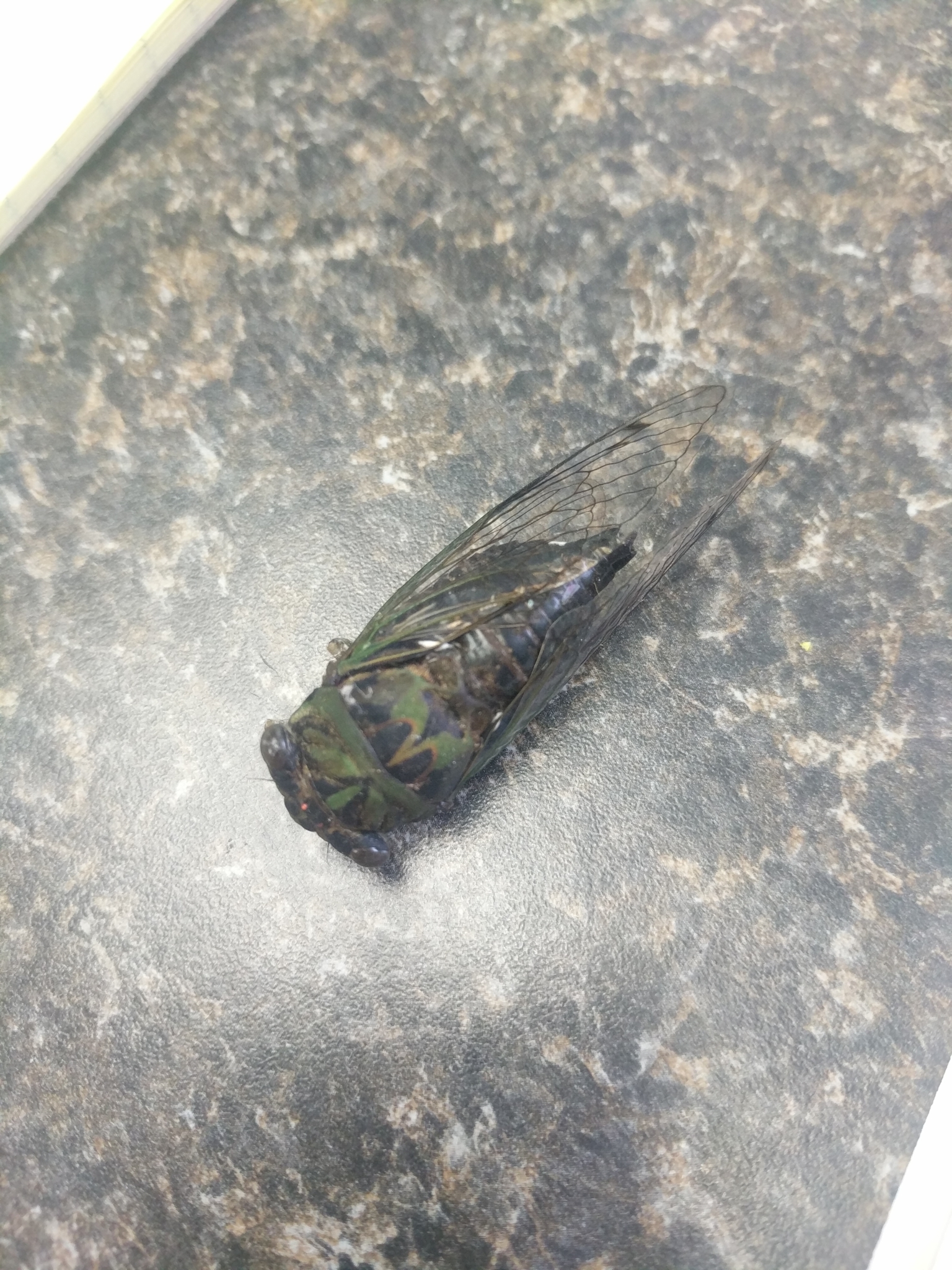Map Snapshot



2 Records
Scissor Grinder in Montgomery Co., Maryland (7/8/2020). (c) Michael Wilpers, some rights reserved (CC BY-NC). - wilpersm via iNaturalist.
Seasonality Snapshot
Source: Wikipedia
| Neotibicen pruinosus | |
|---|---|

| |
| Scientific classification | |
| Domain: | Eukaryota |
| Kingdom: | Animalia |
| Phylum: | Arthropoda |
| Class: | Insecta |
| Order: | Hemiptera |
| Suborder: | Auchenorrhyncha |
| Family: | Cicadidae |
| Genus: | Neotibicen |
| Species: | N. pruinosus
|
| Binomial name | |
| Neotibicen pruinosus (Say, 1825)
| |
Neotibicen pruinosus, commonly known as the scissor grinder, is a species of cicada in the family Cicadidae.[1][2][3][4][5]
Distribution and habitat
[edit]The scissor grinder occurs in most of the eastern United States. It is common in wooded areas, often within grassland environments.[6]
Taxonomy
[edit]All species in the genus Neotibicen used to be part of the genus Tibicen, until Tibicen was split into multiple genera. Neo is Greek for "new" while tibicen is Latin for "flute player" or "piper".[7]
The specific name pruinosus is Latin for "frosty".[8] Its common name, the scissor grinder, comes from its sound, like all the other cicadas that are known as scissor grinders. They all sound like scissors being run over a grinding wheel.[9]
Diet
[edit]Scissor grinders, like all other cicadas, use their proboscis, a type of insect mouthpart similar to a straw, to pierce trees and drink fluid from the xylem.[10]
Description
[edit]The scissor grinder is similar in appearance to many other species in its genus. It is mostly green with many complex markings on its body. Its abdomen is entirely black.

A rare pale variant of the scissor grinder occurs in southeastern Kansas and eastern Oklahoma.[6] This variant is far lighter in coloring than its common variant.[11]

Subspecies
[edit]These two subspecies belong to the species Neotibicen pruinosus:
- Neotibicen pruinosus fulvus (Beamer, 1924) c g
- Neotibicen pruinosus pruinosus g
Data sources: i = ITIS,[12] c = Catalogue of Life,[1] g = GBIF,[2] b = Bugguide.net[3]
See also
[edit]- Neotibicen winnemanna, the eastern scissor grinder
- Neotibicen latifasciatus, the coastal scissor grinder
References
[edit]- ^ a b "Neotibicen pruinosus species details". Catalogue of Life. Retrieved 2018-04-06.
- ^ a b "Neotibicen pruinosus". GBIF. Retrieved 2018-04-06.
- ^ a b "Neotibicen pruinosus Species Information". BugGuide.net. Retrieved 2018-04-06.
- ^ "Neotibicen pruinosus Overview". Encyclopedia of Life. Retrieved 2018-04-06.
- ^ Hill, Kathy B. R.; Marshall, David C.; Moulds, Maxwell S.; Simon, Chris (2015). "Molecular phylogenetics, diversification, and systematics of Tibicen Latreille 1825 and allied cicadas of the tribe Cryptotympanini, with three new genera and emphasis on species from the USA and Canada (Hemiptera: Auchenorrhyncha: Cicadidae)". Zootaxa. 3985 (2). Magnolia Press: 219–251. doi:10.11646/zootaxa.3985.2.3. PMID 26250031.
- ^ a b Sanborn, Allen F.; Phillips, Polly K. (April 9, 2013). "Biogeography of the Cicadas (Hemiptera: Cicadidae) of North America, North of Mexico". Diversity. 5 (2): 166–239. doi:10.3390/d5020166 – via MDPI Open Access Journals.
- ^ "Genus Neotibicen - Annual or Dogday Cicadas". Bug Guide. Retrieved March 15, 2022.
- ^ "Species Neotibicen pruinosus - Scissor(s) Grinder". Bug Guide. Retrieved March 15, 2022.
- ^ Dan (December 2, 2015). "The Smaller Neotibicen". Cicada Mania. Retrieved March 15, 2022.
- ^ Dan (June 28, 2015). "What do Cicadas Eat and Drink?". Cicada Mania. Retrieved March 15, 2022.
- ^ Dan (April 9, 2020). "Neotibicen pruinosus pruinosus (Say, 1825) aka Scissor(s) Grinder". Cicada Mania. Retrieved March 15, 2022.
- ^ "ITIS, Integrated Taxonomic Information System". Retrieved 2018-04-06.
Further reading
[edit]- Arnett, Ross H. Jr. (2000). American Insects: A Handbook of the Insects of America North of Mexico (2nd ed.). CRC Press. ISBN 0-8493-0212-9.
- Sanborn, Allen F. (2009). "Checklist, new species and key to the cicadas of Cuba (Hemiptera, Cicadoidea, Cicadidae)". Deutsche Entomologische Zeitschrift. 56 (1): 85–92. doi:10.1002/mmnd.200900007. ISSN 0012-0073.
- Sanborn, Allen F. (2007). "New species, new records and checklist of cicadas from Mexico (Hemiptera: Cicadomorpha: Cicadidae)". Zootaxa (1651): 1–42. ISSN 1175-5334.
- Sanborn, A.F.; Phillips, P.K. (2013). "Biogeography of the Cicadas (Hemiptera: Cicadidae) of North America, North of Mexico" (PDF). Diversity. 5 (2): 166–239. doi:10.3390/d5020166.
- Van Duzee, E.P. (1915). "A preliminary review of the West coast Cicadidae". Journal of the New York Entomological Society. 23 (1): 21–44.
External links
[edit]- "NCBI Taxonomy Browser". Retrieved 2018-04-06.
 Media related to Neotibicen pruinosus at Wikimedia Commons
Media related to Neotibicen pruinosus at Wikimedia Commons
